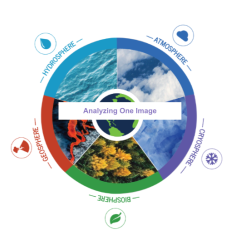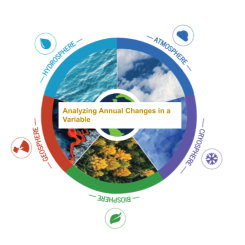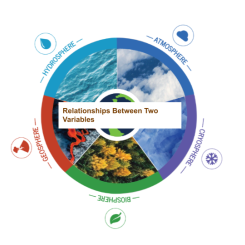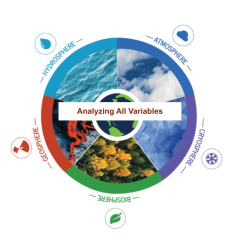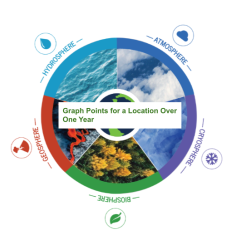Lesson Plans
Earth System Satellite Images - Exploring Relationships Among Variables for a Particular Month
Overview
The Earth System Satellite Images available on My NASA Data provide teachers and students opportunities to explore data and identify relationships between/among different components of the Earth system. The Earth System Satellite Images, along with the Data Literacy Cubes, help the learner visualize how different Earth system variables change over time, establish cause and effect relationships for a specific variable, identify patterns, and determine relationships among variables.
In this lesson, students will compare all of the variables, but for the same month.
This lesson has been adapted and modified from the GLOBE Earth System Poster Learning Activities.
Materials Required
- Earth System Satellite Images (Global or North America)
- Data Literacy Cube Template or number cube (1 per group)
- Data Literacy Cube Map Question Sheet (1 per student)
- Task Cards
- Pen, Pencil
NOTE: Consider laminating the resources in this list for future use.
Procedure
Teacher Preparation before the lesson:
- There are sets of six satellite image cards, one for every other month in a year, for each Earth system variable as listed below.
- Aerosols
- Cloud Cover
- Insolation (solar shortwave radiation)
- Precipitation
- Surface Temperature
- Vegetation
- Print the Earth System Satellite Images (Global or North America) that you plan to use.
- Print one Data Literacy cube template for each group.
- Print a map cube question sheet for each student.
- There are four different levels of map cube question sheets.
- Question Sheets are leveled for both Lexile and English-language proficiencies.
- The leveled question sheets contain labeled (bottom left) and unlabeled versions for you to use at your discretion to help you differentiate your instruction.
- Note: The Lexile range provided on each question sheet represents the text’s difficulty.
- The students’ reading comprehension levels should be taken into account when selecting the appropriate question sheet.
- Regardless of level, the students in each group will be able to follow along, because the cube has the same six set of question categories: Examine, Search and Find, Analyze, Ask, Connect, and Assess.
- Some of the question sheets include sentence stems to help struggling readers/writers participate in responding to the questions.
Part I: Using the Cube
- Divide the class into small groups. It is best not to have more than six students per group.
- Each group will have:
- A different variable, but for the same month.
- Distribute:
- Map question sheet (for each student)
- Cube for each group
- Earth System Satellite Images (Global or North America)
- Optional: Use the task card to assign their roles (project manager, data manager, chief engineer, and communications manager). Be creative and assign other roles!
- Assign a person in each group to roll the cube.
- In their groups, they will answer questions 1–6 on the map question sheet.
Part II: Fishbowl Activity
The fishbowl activity is a student-led discussion to help them better understand a complex topic and to aid with comprehension for students of different abilities. Monitor and intervene as necessary.
- Form new groups so that each group has a person from each of the variables for the same month.
- Allow time for the new group to discuss and compare the variables.
- Place the variables side by side, and have them compare the images.
- Choose one of the groups to be in the fishbowl, while the others remain on the outside. The groups on the outside of the fishbowl should take notes of what the team inside the fishbowl is discussing.
- Use some or all of the following guiding questions:
- Which regions experience the extreme highs and lows for each variable?
- Which regions don’t experience the extremes?
- Why do you think this occurs?
- What differences, if any, do you find between variations of variables over the oceans versus variations in variables over the continents?
- What amounts of insolation, surface temperature, cloud fraction, precipitation and aerosols characterize the world’s most vegetated regions for a particular month?
- Where is the greatest concentration of aerosols originating from and how would you characterize that particular environment based on the six images?
- Use a timer and rotate the groups so that they all have an opportunity to be inside the fishbowl and respond to the questions you select, or you can have the students create and ask questions to the group inside of the fishbowl.
- Use sentence frames to support the student-led discussion for this activity:
- This is similar to___________ because...
- This is different to_________ because...
- This reminds me of_________.
- I disagree with the statement because ________.
- I like how you said ________.
Part III: Close Lesson
- Use the Earth System Satellite Images Graphic Organizer to compare variables and how they are connected within the Earth System.
- Create questions related to all of the variables. For example: Observe the locations on the map. What differences are observed within the same months, for different variables?
- Once the students have had time to complete their graphic organizers, you can moderate a discussion so that students can describe the similarities and differences among the variables.
Disciplinary Core Ideas:
- ESS2A: Earth Materials and Systems
- ESS2D: Weather and Climate
- ESS3C: Human Impacts on Earth Systems
Crosscutting Concepts:
- Patterns
- Cause and Effect
- Systems and System Models
Science and Engineering Practices:
- Developing and Using Models
- Analyzing and Interpreting Data
- Obtaining, Evaluating and Communicating Information
The learners will be able to:
- Discover, analyze, and interpret patterns in a graphic display of data
- Conduct an analysis of mapped data
- Develop descriptions and explanations using evidence
- Develop an understanding of the interactions within the Earth system
- Establish cause and effect relationships for a specific variable, identify patterns, and determine relationships between variables
- How can comparing variables on a map determine if there are any changes happening?
The processes comprising the Earth’s environment are interconnected. Understanding how these connections operate on a global scale is to understand the Earth as a system. Understanding the Earth as a system requires a quantitative exploration of the connections among various parts of the system. These processes take place in and between the atmosphere, oceans, fresh water, ice, soil, and living components. These processes also include energy from the Sun, and the gases and particles that enter the atmosphere and oceans from both natural and anthropogenic, or human-caused, sources. The activities in this guide will help students understand variations in environmental parameters by examining connections among different phenomena measured on local, regional and global scales. As students look at the connections between environmental data, they will see that the environment is the result of the interplay among many processes that take place on varying time and spatial scales. They will also understand that environmental processes are not bound by oceans, mountains, or country delineations–they are truly global in scope.
Students need to be familiar with longitude and latitude, as well as familiarity with qualitative and quantitative observations.
| Studying how Earth’s systems interact is as important as studying the individual systems. NASA and its international partners operate several Earth-observing satellites, collectively called the A-Train, that closely follow one after another along the same orbital track. The near-simultaneous observations of a wide variety of factors help the scientific community advance our knowledge of Earth-system science and apply this knowledge for the benefit of society. Source: NASA 60 Years and Counting |
- Standalone Lesson (no technology required)
- Internet Required

